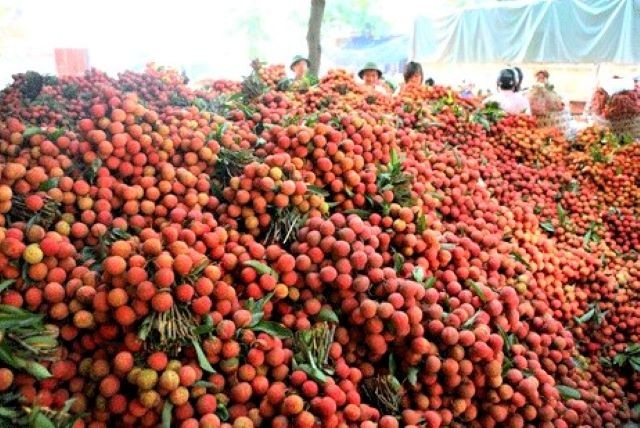
1. Origin and Growing Regions of Vietnamese Lychee
Lychee (scientific name: Litchi chinensis) originated in Southern China and Southeast Asia. In Vietnam, lychee trees have been cultivated for a long time and have become an indispensable part of local agriculture and culture.
Key lychee growing regions in Vietnam are mainly concentrated in the Northern provinces, especially:
- Bac Giang: Known as the “lychee capital” of Vietnam. Luc Ngan lychee (Bac Giang) is famous for its superior quality, distinctive sweetness, fragrant aroma, thick flesh, and small seeds.
- Hai Duong: Along with Bac Giang, Hai Duong is one of the major lychee growing areas, particularly Thanh Ha lychee, which is known for its large, juicy, and subtly sweet fruit.
- Hung Yen, Quang Ninh, Lang Son: These provinces also have significant lychee cultivation areas, contributing to the total national lychee output.

2. Nutritional Value of Lychee
Lychee is not only delicious but also contains many important nutritional values, offering numerous health benefits:
- Vitamin C: Lychee is very rich in vitamin C, a powerful antioxidant that helps boost the immune system, protect cells from damage, and promote collagen production.
- Dietary Fiber: Provides dietary fiber, which supports a healthy digestive system, prevents constipation, and helps maintain a feeling of fullness.
- Minerals: Contains essential minerals such as potassium (helps regulate blood pressure), copper (important for red blood cell formation), and phosphorus.
- Plant Compounds: Lychee contains many beneficial plant compounds like flavonoids and polyphenols, which have antioxidant and anti-inflammatory effects.
- Water and Energy: Lychee has a high water content, helping to hydrate the body, while also providing energy due to its natural sugar content.

3. Products Made from Vietnamese Lychee
Besides fresh consumption, lychee is processed into a variety of products, meeting market demand and increasing the value of the fruit:
- Fresh Lychee: The primary product, consumed directly and exported.
- Dried Lychee: Dried lychee can be preserved longer and is used as a snack or an ingredient in desserts.
- Lychee Juice, Lychee Syrup: Lychee-based beverages are popular.
- Canned Lychee: Lychee in syrup is convenient for easy use and storage.
- Lychee Jam, Lychee Candy: Processed lychee products offer unique flavors.
- Lychee Wine: Some places also produce lychee wine with a distinctive taste.
4. Export Markets for Vietnamese Lychee
Vietnamese lychee has been expanding its export markets, gradually asserting its quality on the international stage:
- Traditional Market: China is the largest and traditional export market for Vietnamese lychee due to its close geographical proximity and large consumption demand.
- Demanding Markets: Vietnamese lychee has successfully penetrated markets with high requirements for quality and food safety, such as:
- Japan: One of the most demanding markets, Vietnamese lychee must meet strict standards for plant quarantine and pesticide residue.
- EU (European Union): Countries in the EU like France, Germany, and the Netherlands are also potential markets.
- United States: A large market with diverse demands for tropical fruits.
- Australia: Another potential market for Vietnamese lychee.
- Other Markets: South Korea, Canada, the Middle East, and Southeast Asian countries are also important destinations.
5. Advantages and Challenges of Vietnamese Lychee for Export
Advantages:
- Superior product quality: Especially Luc Ngan and Thanh Ha lychees, famous for their distinctive delicious flavor, thick flesh, and small seeds.
- Large area and output: Vietnam has extensive lychee growing areas and high annual output, meeting export demands.
- Long-standing cultivation experience: Farmers have long experience in cultivating lychee, applying traditional and modern farming techniques.
- Favorable climatic conditions: The tropical monsoon climate creates ideal conditions for lychee trees to thrive.
- Government and agricultural sector support: There are many policies and programs to support farmers and businesses in production, processing, and trade promotion.
- Free Trade Agreements (FTAs): Vietnam participates in many FTAs, helping to reduce tariffs and create favorable conditions for export.
Challenges:
- High technical requirements and standards from import markets: Especially demanding markets like Japan, the EU, and the US, which require lychee to meet strict GlobalGAP, VietGAP certifications, and phytosanitary requirements.
- Transportation and preservation costs: Lychee is a perishable fruit, requiring advanced cold chain technology for preservation and transportation, which increases costs.
- Fierce competition: Vietnamese lychee faces competition from lychee from other countries such as China and Thailand.
- Climate change: The impacts of climate change such as droughts and floods can affect lychee yield and quality.
- Reliance on traditional markets: Although markets have been diversified, reliance on the Chinese market remains significant, making it vulnerable to policy changes.
- Lack of synchronized processes in production and processing: There is still fragmented production and a lack of links between farmers and businesses, affecting consistent quality and traceability.
- Post-harvest technology: Post-harvest processing, preservation, and packaging technology are still limited in some regions, reducing the shelf life of lychee.
Other articles:
Other agricultural products:


